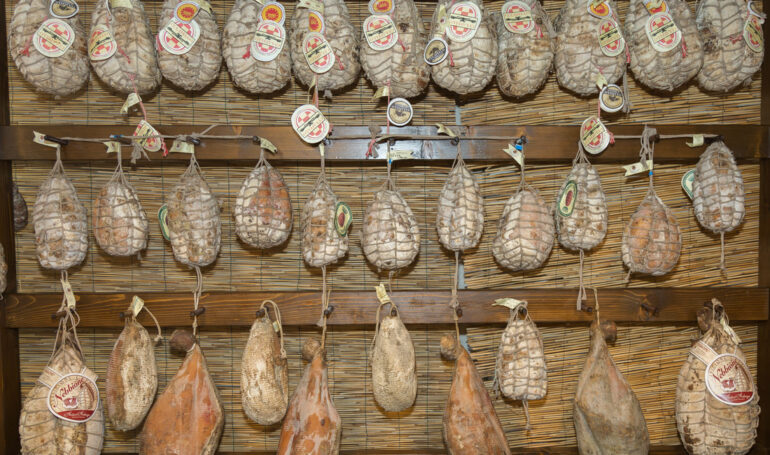
Culatello di Zibello – Italy’s Most Prestigious Cured Meat
If you were to ask me what my favorite food is, like absolute favorite, that I could eat all day and every day of my life, my answer would have to be thinly sliced, authentic prosciutto di Parma or prosciutto San Daniele. It’s as close to my version of the perfect food as you can get.
Truth be told, I love all sulumi, and if not for the salt intake, I would probably eat them daily. I have no doubt that you have all heard of prosciutto, soppresata, mortadella, speck and pancetta. But have you heard of Culatello di Zibello? Culatello, or “little ass,” in Italian, is the most prestigious cured meat of Italy, perhaps the world, and if you haven’t heard of it, it’s likely because until the last few years, it couldn’t be imported in the U.S. But now that the U.S. Agricultural Department has approved its (and many other salami) importation, run, don’t walk to your nearest authentic Italian shop and order yourself some Culatello di Zibello. But you may have a hard time finding it still, and at the present moment, Eataly is one of the few importers of the real stuff.

Produced in far less quantity than prosciutto and some of the other delicacies mentioned above, Culatello is coveted not just due to its limited quantity, but because it’s made from the best part of the pork’s leg, the meatiest crural muscle. Wrapped in natural casing, usually clean pork bladder, it’s produced from the boneless portion of the inner part of the thigh and pig rump, the most tender part. The meat is then cleaned and shaped and seasoned with salt, pepper and some garlic. The meat is gingerly rubbed with these seasonings, pressing into the meat to increase its flavor. It’s then refrigerated for several days to absorb the salt and other seasonings.

Once seasoned, the meat is wrapped in twine, purposefully given it the distinctive pear shape. The finished product weighs in at just about 5 kilos. During the curing process, they require a lot of attention. Turned and rotated every few months, the producer, known as a salumaio in Italian, must know exactly when to open the cellar windows to let in the local Po River breeze. Certified by the European Designation of Origin (DOP), Culatello must be produced only in the Emilia Romagna region, particularly in Parma and its neighbors. A consortium was created to defend the authenticity of the product. Producers receive regular visits from governing agencies to assure that the strict curing methods are adhered to. And to this day, only a few thousands are produced annually.
After its curing process, the meat is hard, so the twine is removed and the culatello is actually wrapped for several days in linen cloths that have been soaked in very dry white wine, this soften it up and gives the final product additional flavor.

Many believe that the flavor is largely due in part to its geographical location of the production, the local weather and mountain air, and the fog rising form the Po. Unlike prosciutto, culatello thrives in year-round dampness found specifically in this location. The cold and foggy months of winter and extremely hot summers of northern Italy make it an ideal environment and climate for curing this particular delicacy. Produced only from November to February, some claim that the closer the cellars are to the Po River, the tastier the final product.
So, you may be asking, how does it taste?? The flavor of culatello is delicate and sweet. The meat almost melts in your mouth. The scent is distinctive, almost funky, and overall can be used in many of the same ways that other Italian delicacies are used. Not surprising, a chunk of the local Parmigiano Reggiano goes perfectly well with culatello and a glass of local wine. Thinly hand-slicing is the preferred way of cutting it. And at $60.00+ per pound, Culatello is surely an item for special occasions, or to impress friends, but is a must try, if only on rare occasions.

If you’re having difficulty finding the real thing here in the US, consider joining us in May 2020 as we enjoy a full week in the Emilia Romagna region and we explore its renowned products. Enjoy a visit to a certified culatello di Zibello producer, where we will learn all about the curing process and visit the cellars. And of course, sample as much Culatello as we like.
Be sure to visit our tour page here for all info on this delicious week!

What to Pack for Italy
Cosa Mettere in Valigia per l'Italia
Everyone is always asking me what they should pack for Italy,
so I’ve created a quick reference guide that you can use for your next trip.
Hint: You don’t need nearly as much as you think you do!

Leave a Reply